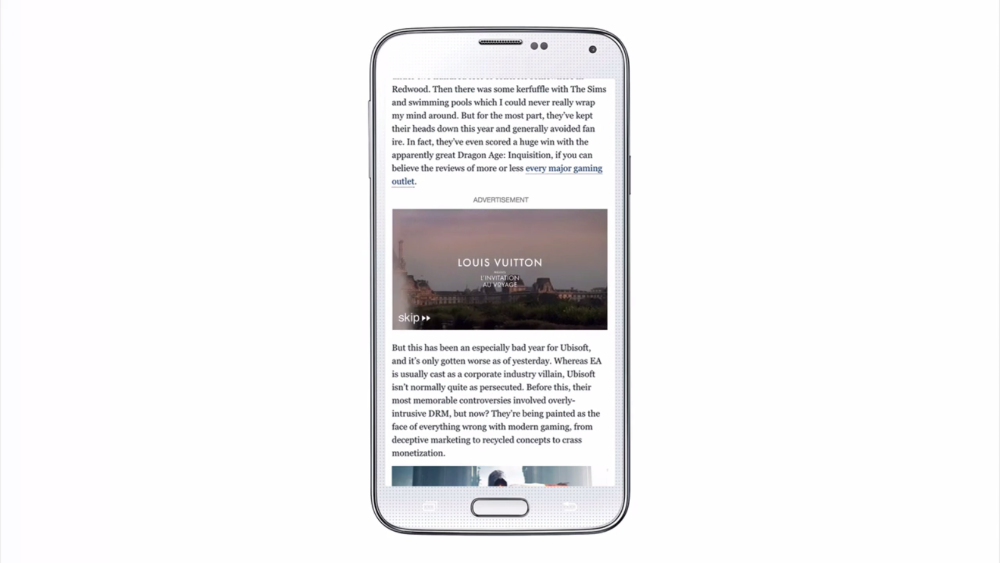mobilemarketingmagazine.com
 With concerns growing over the impact that ad blocking has on traditional forms of display and video advertising, many publishers and advertisers are looking for alternative methods of reaching consumers. Native advertising, especially native video, has seen rapid growth over the past few years, and many firms are investing increasing amounts in finding ways to organically deliver brand content to users.
With concerns growing over the impact that ad blocking has on traditional forms of display and video advertising, many publishers and advertisers are looking for alternative methods of reaching consumers. Native advertising, especially native video, has seen rapid growth over the past few years, and many firms are investing increasing amounts in finding ways to organically deliver brand content to users.
 With concerns growing over the impact that ad blocking has on traditional forms of display and video advertising, many publishers and advertisers are looking for alternative methods of reaching consumers. Native advertising, especially native video, has seen rapid growth over the past few years, and many firms are investing increasing amounts in finding ways to organically deliver brand content to users.
With concerns growing over the impact that ad blocking has on traditional forms of display and video advertising, many publishers and advertisers are looking for alternative methods of reaching consumers. Native advertising, especially native video, has seen rapid growth over the past few years, and many firms are investing increasing amounts in finding ways to organically deliver brand content to users.
Native advertising had something of an awkward introduction to the digital world, with many advertisers thinking it was limited to sponsored content and social media posts. But as native ad units evolve to be more complex, the format is coming into its own, just in time to help combat the rise of ad blocking.
According to eMarketer, 46 per cent of UK mobile display ad spending in 2014 went on content and native advertising, more than standard display (32 per cent) and mobile video (21 per cent). This growth is being driven by effectiveness, with a study by Yahoo showing that 85 per cent of mobile users noticed ads in mobile content streams, as opposed to 64 per cent who noticed standard display formats on mobile.
“When you’re on a mobile, on a smaller screen, the advertising has to be complementary and additive to the experience, and if it isn’t then the users depart,” said Nick Hugh, vice president for EMEA at Yahoo. “That’s why a couple years ago, we moved all standard display formats from mobile, and we’ve focused singly on native. It’s in the stream of content, it’s immersive and it doesn’t distract from the experience.”
Along with issues over page load times and data privacy, the distracting nature of advertising, particularly formats like unskippable pre-roll, is the major driving pushing consumers towards the adoption of ad blocking. In fact, when YouTube first introduced unskippable pre-roll, ad blocker adoption saw its first major spike, and it has continued to grow at a sharp rate ever since.
“When you look at pre-roll advertising, along with pop-up banners, they’re the two most intrusive forms of advertising,” said Todd Tran, global managing director of mobile and programmatic at Teads. “In Germany, two-thirds of pre-roll video ads are ad blocked. That’s the end of pre-roll in Germany. It’s over. And it’s going to get worse.
“On mobile, there is no future for pre-roll. Non-skippable pre-roll? Forget it. Nobody’s going to accept it, no customer wants it. Native video is not only more acceptable to consumers, but there’s more inventory available, and it’s why our business is now almost 50 per cent mobile.”
While the majority of internet and mobile users still don’t have ad blocking software installed, the figure continues to grow, with recent IAB figures suggesting that it rose over 20 per cent in just four months last year, with almost a quarter of British adults now employing some form of content blocking.
 Slowing down and even stopping this rise is only part of the equation when it comes to solving ad blocking. The other part is finding ways to encourage users to abandon their ad blockers once they’ve been put in place, and renew the value exchange that forms the basis of the free internet. The IAB offered publishers guidance earlier this week in the form of its ‘DEAL’ plan, but Nick Hugh is less confident about the ad industry’s ability to bring people back.
Slowing down and even stopping this rise is only part of the equation when it comes to solving ad blocking. The other part is finding ways to encourage users to abandon their ad blockers once they’ve been put in place, and renew the value exchange that forms the basis of the free internet. The IAB offered publishers guidance earlier this week in the form of its ‘DEAL’ plan, but Nick Hugh is less confident about the ad industry’s ability to bring people back.
“The challenge of ad-blocking is that it’s a bit of a blunt instrument. It solves a problem that everyone agrees on, which is that advertising on mobile isn’t at the level it needs to be, as an industry. However, an ad blocker will tend to say ‘I’m going to block at a network level, I’m going to block all publishers’. But that is actually penalising the publishers that do treat their users well, because of some of the actions of lower quality publishers.
“Without naming any names, there are some broadcasters that will make you watch a whole load of ads before you can actually see the content. That does create a challenge for us, and there should be a limit to the number of ads, whether they are skippable, and so forth.
“The other thing is, if you look at what some the ad blocking companies are saying, they are creating these committees to say ‘this is an acceptable ad’ or not. Now, I have never seen, from an ad blocker, any research to say what is or not. We have very open mechanics with our users for them to be able to inform us what is a good ad and what isn’t, and then we take actions based off that. We need more people to follow that stream, and that would solve the problem that’s at the core of ad blocking.”
The growth of ad blocking has placed many publishers in a tricky position when it comes to ensuring their adverts are actually reaching people, with some choosing to force consumers who use ad blockers to deactivate them before they access content. Along with its recent guidance on ad blocking for publishers, the IAB released an open-source script that would enable website owners to identify users with ad blockers, and suggested they use it to limit the content they could access.
 However, according to Todd Tran, this kind of behaviour is will only lead to more resentment between consumers and publishers, and will result in a race to the bottom between ad blockers, publishers and ad tech firms, rather than an overall improvement in the type of advertising served across the internet and mobile.
However, according to Todd Tran, this kind of behaviour is will only lead to more resentment between consumers and publishers, and will result in a race to the bottom between ad blockers, publishers and ad tech firms, rather than an overall improvement in the type of advertising served across the internet and mobile.
“Right now, there’s a reduction in available inventory, but not by that much, not to the point where advertisers are feeling it,” said Tran. “Publishers are really feeling it, because it impacts them the most, and they have to change. There are two ways you can change if you’re a publisher. One way is that you can get angry at consumers for blocking the ads. The other way is just stop annoying the consumer. I think you can do both, but I think that ‘stop annoying the consumer’ is the more long-term, sustainable model.
“When you look at the rise of ad blocking, the growth has been pretty dramatic, and it’s for a simple reason. Consumers are telling the industry that they’re tired of intrusiveness in advertising. We did a study together with a research company that showed the number one reason people install an ad blocker is intrusiveness in advertising, unsurprisingly.
“But when you ask what’s the number one motivator for you to unblock the ads, to remove your ad blocker, the number one motivator is if we gave them the choice of whether or not they want to watch the ad. If we gave them that choice they will uninstall their ad blocker. 79 per cent of people would reconsider their ad blocker if you gave them that choice.”
The advertising industry as a whole has invested a huge amount of money in digital advertising, and ad blocking represents a fundamental threat to the ecosystem it has created. While many aspects of mobile will continue relatively smoothly (with in-app advertising making up the majority of spending, and much harder to block), advertisers and publishers who are using the web need to take action if they want to avoid the rapidly approaching conflict that ad blocking signifies. Native advertising may represent the best opportunity for publishers and advertisers to transition to a new form of more acceptable messaging, and to win back the trust of consumers in the process.
No comments:
Post a Comment